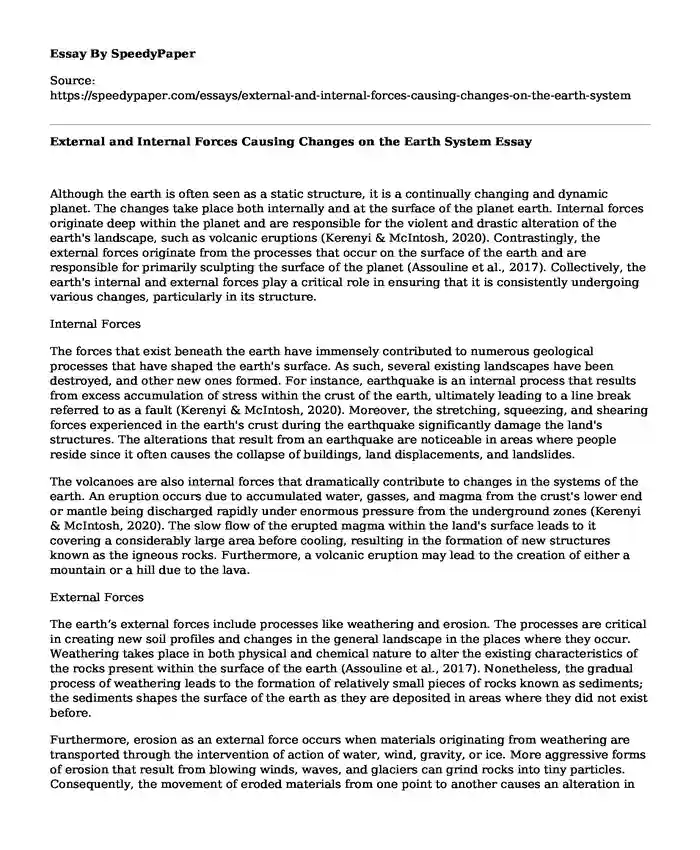
| Type of paper: | Essay |
| Categories: | Business Nursing Law Technology Historical events & places |
| Pages: | 3 |
| Wordcount: | 662 words |
Although the earth is often seen as a static structure, it is a continually changing and dynamic planet. The changes take place both internally and at the surface of the planet earth. Internal forces originate deep within the planet and are responsible for the violent and drastic alteration of the earth's landscape, such as volcanic eruptions (Kerenyi & McIntosh, 2020). Contrastingly, the external forces originate from the processes that occur on the surface of the earth and are responsible for primarily sculpting the surface of the planet (Assouline et al., 2017). Collectively, the earth's internal and external forces play a critical role in ensuring that it is consistently undergoing various changes, particularly in its structure.
Internal Forces
The forces that exist beneath the earth have immensely contributed to numerous geological processes that have shaped the earth's surface. As such, several existing landscapes have been destroyed, and other new ones formed. For instance, earthquake is an internal process that results from excess accumulation of stress within the crust of the earth, ultimately leading to a line break referred to as a fault (Kerenyi & McIntosh, 2020). Moreover, the stretching, squeezing, and shearing forces experienced in the earth's crust during the earthquake significantly damage the land's structures. The alterations that result from an earthquake are noticeable in areas where people reside since it often causes the collapse of buildings, land displacements, and landslides.
The volcanoes are also internal forces that dramatically contribute to changes in the systems of the earth. An eruption occurs due to accumulated water, gasses, and magma from the crust's lower end or mantle being discharged rapidly under enormous pressure from the underground zones (Kerenyi & McIntosh, 2020). The slow flow of the erupted magma within the land's surface leads to it covering a considerably large area before cooling, resulting in the formation of new structures known as the igneous rocks. Furthermore, a volcanic eruption may lead to the creation of either a mountain or a hill due to the lava.
External Forces
The earth's external forces include processes like weathering and erosion. The processes are critical in creating new soil profiles and changes in the general landscape in the places where they occur. Weathering takes place in both physical and chemical nature to alter the existing characteristics of the rocks present within the surface of the earth (Assouline et al., 2017). Nonetheless, the gradual process of weathering leads to the formation of relatively small pieces of rocks known as sediments; the sediments shapes the surface of the earth as they are deposited in areas where they did not exist before.
Furthermore, erosion as an external force occurs when materials originating from weathering are transported through the intervention of action of water, wind, gravity, or ice. More aggressive forms of erosion that result from blowing winds, waves, and glaciers can grind rocks into tiny particles. Consequently, the movement of eroded materials from one point to another causes an alteration in the landscaping of the earth's surface since the elevation is significantly lowered in some areas while increased in other locations (Assouline et al., 2017). For instance, topsoil carried by water from a hill to the river may lead to the river being narrow. In most cases, erosion through its various forms redefines the coastal regions, landforms, riverbanks, and riverbeds.
In conclusion, the earth is a dynamic planet. As such, the earth is subject to consistent changes that result from two primary forces referred to as internal and external forces. The two forces are responsible for the changes that happen within the earth's surface and underneath the earth. Nonetheless, the forces take place progressively through various means hence subjecting the universe to several distinct motions.
References
Assouline, S., Govers, G., & Nearing, M. A. (2017). Erosion and lateral surface processes. Vadose Zone Journal, 16(12). https://doi.org/10.2136/vzj2017.11.0194Kerenyi, A., & McIntosh, R. W. (2020). Internal Material Flows in the Earth and Their Effects on the Society. In Sustainable Development in Changing Complex Earth Systems (pp. 59-74). Springer, Cham. https://doi.org/10.1007/978-3-030-21645-0_3
Cite this page
External and Internal Forces Causing Changes on the Earth System. (2023, Aug 23). Retrieved from https://speedypaper.com/essays/external-and-internal-forces-causing-changes-on-the-earth-system
Request Removal
If you are the original author of this essay and no longer wish to have it published on the SpeedyPaper website, please click below to request its removal:
- Free Essay with the Ad Rhetorical Review
- Essay Sample on Computer Ethics, and Their Importance
- Essay Example on M4BL Policy Platform
- Essay Example: ISACA Certifications
- Essay Sample on Difference Between Assessment and Evaluation in Nursing
- Free Essay Example - Corporate Position
- Free Paper Sample: Technology and Service Delivery in Government and Public Service
Popular categories




